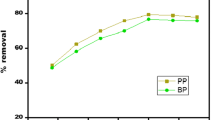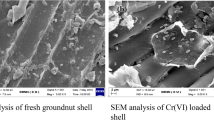Abstract
Adsorption efficiency of three adsorbents in the removal of Rhodamine B from aqueous solutions and industrial effluent is presented herewith. Carbonized groundnut seed cake powder, sesame seed cake powder, and coconut cake powder were used as adsorbents. Batch adsorptive removal of the dye was optimized at pH 7 with groundnut seed cake powder and sesame seed cake powder and at pH 2 with coconut cake powder. Adsorbent dosage of 0.27 g,0.25 g, and 0.26 g was found to be optimum with groundnut seed cake powder, sesame seed cake powder, and coconut cake powder, respectively. With all the three adsorbents, a contact time of 150 min, the temperature of 50 °C, and an initial dye concentration of 10 mg L−1 were optimized, respectively. Using the three adsorbents, 99.7% removal of the dye was observed. Isothermal studies indicated that the Langmuir isotherm model is suited for the present work. The results of the kinetic studies showed that the process followed pseudo-second order. Prediction of adsorption efficiency of the three chosen adsorbents has been carried out by using artificial neural networks (MATLAB 2013A). Back propagation and L-M algorithm were used for modeling optimization parameters, and the three adsorbents were given as inputs to run the network. The results obtained were compared with the experimental results and found to have a relative error of 0.2%.





Similar content being viewed by others
Data availability
Not applicable
References
Xiaojun T, Shuang W, Li Z (2020) Ultrasound assisted bottom-up synthesis of Ni graphene hybrid composites and their excellent Rhodamine B removal properties. J Environ Manage 255:109834
MA AL-T, Al-Qadi ZS (2016) Preparation and utilization of corncob activated carbon for dyes removal from aqueous solution batch and continuous study. Babylon univ eng scis J 24(3):700–712
Ptaszkowska-Koniarz M, Goscianska J, Pietrzak R (2018) Removal of rhodamine B from water by modified carbon xerogels. Colloids Surf, A 543:109–117
Karami M, Sharafi K, Asadi A, Bagheri A, Yosefvand F, Charganeh SS et al (2016) Degradation of reactive red 198 (RR198) from aqueous solutions by advanced oxidation processes (AOPS): O3, H2O2/O3 and H2O2/ultrasonic. Bulgarian Chemical Communications 48(Specia):43–49
Selvakumar A, Rangabhashiyam S (2019) Biosorption of Rhodamine B onto novel biosorbents from Kappaphycus alvarezii,Gracilaria salicornia and Gracilaria edulis. Environ Pollut 255:113291
Khudhair A, Al-Rudaini J (2017) Adsorption removal of Rhodamine-B dye from aqueous solution using rhamnus stone as low cost adsorbent. Al Nahrain journal of Science 20(1):32–41
Postai DL, Demarchi CA, Zanatta F, Melo DCC, Rodrigues CA (2016) Adsorption of rhodamine B and methylene blue dyes using waste of seeds of Aleurites Moluccana, a low cost adsorbent. Alex Eng J 55:1713–1723
Bello OS, Adegoke KA, Sarumi OO, Lameed OS (2019) Functionalized locust bean pod (Parkia biglobosa) activated carbon for Rhodamine B dye removal. Heliyon 5:e02323
Zhao Y, Lin Z, Liu J (2019) Insights into enhanced adsorptive removal of Rhodamine B by different chemically modified garlic peels: comparison, kinetics, isotherms, thermodynamics and mechanism. J Mol Liq 293:111516
Rahdar S, Rahdar A, Zafar MN, Shafqat SS, Ahmadi S (2019) Synthesis and characterization of MgO supported Fe–Co–Mn nanoparticles with exceptionally high adsorption capacity for Rhodamine B dye. J Mater Res Technol 8(5):3800–3810
Hou Y, Huang G, Li J, Yang Q, Haung S, Cai J (2019) Hydrothermal conversion of bamboo shoot shell to biochar: preliminary studies of adsorption equilibrium and kinetics for rhodamine B removal. J Analy Appl Proly 143:104694
Han R, Zhang Y, Xie Y (2019) Application of Mn3O4 nanowires in the dye waste water treatment at room temperature. Sep Purif Technol 234:116119
Huang C, Wang Y, Gong M (2020) α-MnO2/Palygorskite composite as an effective catalyst for heterogeneous activation of peroxymonosulfate (PMS) for the degradation of Rhodamine B. Separation and purification Tehcnology 230:11587
Krishna SK, Siva Prakash S (2015) Removal of dyes by using various adsorbents: a review. Int Journal Apl Chem:195–202
Laysandra L, Sari MW, Soetaredjo FE, Foe K, Putro JN, Kurniawan A, Ju YH, Ismadji S et al (2017) Adsorption and photocatalytic performance of bentonite-titanium dioxide composites for methylene blue and rhodamine B decoloration. Heliyon 3(12):e00488
El-Sayed GO, Yehia MM, Asaad AA (2014) Assessment of activated carbon prepared from corncob by chemical activation with phosphoric acid. Water Resources and Industry 7:66–75
Lopes GK, Zanella HG, Spessato L, Ronix A, Viero P, Fonseca JM et al (2021) Steam-activated carbon from malt bagasse: optimization of preparation conditions and adsorption studies of sunset yellow food dye. Arabian Journal of Chemistry 14:103001
Pathania D, Sharma S, Singh P (2017) Removal of methylene blue by adsorption onto activated carbon developed from Ficus carica bast. Arab J Chem 10:S1445–S1451
Rangabhashiyam S, Balasubramanian P (2018) Adsorption behaviors of hazardous methylene blue and hexavalent chromium on novel materials derived from Pterospermum acerifolium shells. J Mol Liq 254(1):433–445
Kumar PS, Ramalingam S, Kirupha SD, Murugesan A, Vidhyadevi T, Sivanesan S (2011) Adsorption behavior of nickel (II) onto cashew nut shell: equilibrium, thermodynamics, kinetics, mechanism and process design. Chem Eng J 167(1):122–131
Hossain M, Ngo HH, Guo W, Nguyen T (2012) Removal of copper from water by adsorption onto banana peel as bioadsorbent. Int J Geomate 2(2):227–234
Homagai PL, Ghimire KN, Inoue K (2010) Adsorption behavior of heavy metals onto chemically modified sugarcane bagasse. Bioresour Technol 101(6):2067–2069
Zheng J, Zhao Q, Ye Z (2014) Preparation and characterization of activated carbon fiber (ACF) from cotton woven waste. Appl Surf Sci 299:86–91
Malkoc E, Nuhoglu Y (2005) Investigations of nickel (II) removal from aqueous solutions using tea factory waste. J Hazard Mater 127(1–3):120–128
Zhang Z, Lei Y, Li D, Zhao J, Wang Y, Zhou G et al (2020) Sudden heating of H3PO4-loaded coconut shell in CO2 flow to produce super activated carbon and its application for benzene adsorption. Renew Energy 153:1091–1099
Siddiqui SH (2017) The removal of Cu 2+, Ni 2+ and methylene blue (MB) from aqueous solution using Luffa Actangula carbon: kinetics, thermodynamic and isotherm and response methodology. Groundwater for Sustainable Development
Al-Gheethi AA, Azhar QM, Kumar PS, Yusuf AA, Al-Buriahi AK, Mohamed RMSR, Al-shaibani MM (2022) Sustainable approaches for removing Rhodamine B dye using agricultural waste adsorbents: a review. Chemosphere 287:132080
GVSR PK, Malla K a, Bharath Y, Srinivasa Rao K (2020) Withdrawal of Mn(II) from aqueous solution using three low cost adsorbents. Journal of Indian Chemical Society 96:5
Pavan Kumar GVSR, Malla K a, Bharath Y, Srinivasa Rao K (2019) Removal of hexavalent chromium from aqueous solution suing three low cost adsorbents and ANN modeling. Journal of Indian Chemical Society 95:4
Pavan Kumar GVSR (2019) Sk Imran and Srinivasa Rao K, Utilization of three low cost adsorbents in their native as well as carbonized form in the removal of Co(II). Journal of Indian Chemical Society 96(3):399–405
Chandra Rao D, Ramadevi D, VaniP BK, Narasimha Raju CBV, Satyabalaji T (2021) Isothermal, kinetic and thermodynamic studies for the adsorptive removal of pregabalin from aqueous solution as well as industrial effluents. Chemical Science reviews and letters 10(39):410–417
Pavan Kumar GVSR, Malla K a, Bharath Y, Srinivasa Rao K (2019) Removal of Cu (II) using three low-cost adsorbents and prediction of adsorption using artificial neural networks. Applied water Science 9(3):1–9
MaryamK NG, Babak M, Mohsen R (2013) Removal of methylene blue from wastewater by adsorption onto ZnCl2 activated corn husk carbon equilibrium studies. J Chem 2013:383985
Cheng Z-L, Li Y-x, Liu Z (2017) Fabrication of graphene oxide/ silicalite-1 composites with hierarchical porous structure and investigation on their adsorption performance for rhodamine B. J Ind Eng Chem 55:234–243
Mouni L, Belkhiri L, Bollinger J-C, Bouzaza A, Assadi A, Tirri A et al (2018) Removal of methylene blue from aqueous solutions by adsorption on Kaolin: kinetic and equilibrium studies. Appl Clay Sci 153:38–45
Nethaji S, Sivasamy A, Mandal A (2013) Preparation and characterization of corn cob activated carbon coated with nano-sized magnetite particles for the removal of Cr (VI). Bioresour Technol 134:94–100
Saigal ZM, Ahmed AM (2021) Separation of Rhodamine B dye from aqueous media using natural pomegranate peels. Indoes J Chem 21:212–214
Oyekanmi AA, Ahmed A, Hossain K, Rafatullah M (2019) Adsorption of Rhodamine B dye from aqueous solution onto acid treated banana peel: response surface methodology, kinetics and isotherm studies. PLOSONE 14:e0216878
Wang S, Zhu ZH (2007) Effect of acidic treatment of activated carbons on dye adsorption. Dyes and Pigments 75:306–314
Janos P, Buchtovca H, Ryznarova M (2003) Sorption of dyes from aqueous solutions on to fly ash. Water Res 37:4938–4944
Namasivayam C, Radhika R, Subhas S (2001a) Uptake of dyes by promising locally available agricultural solid waste: coir pith. Waste Manag 21:381–387
Jain R, Mathur M, Sikarwar S, Mittal A (2007) Removal of the hazardous dye Rhodamine B through photolytic and adsorption treatments. J Environ Manage 85:956–964
Jain R, Mathur M, Sikarwar S, Mittal A (2007) Removal of the hazardous dye Rhodamine B through photocatalytic and adsorption treatments. J Environ Manage 85:956–964
Namasivayam C, Muniswamy N, Gayatri K, Rani M, Ranganath K (1996) Removal of dyes from aqueous solutions by cellulosic waste orange peel. Bioresour Technol 57:37–43
Annadurai G, Juang R, Lee D (2002) Use of cellulose based wastes for adsorption of dyes from aqueous solutions. J Hazard Mater B92:263–274
Sarma J, Sarma A, Bhattacharya KG (2008) Biosorption of commercial dyes on Azadirachta indica leaf powder: a case study with a basic dye Rhodamine B. Industrial and Engineering Chemistry Research 47:5433–5440
Zhao Y, Yang H, Sun J, Zhang Y, Xia S (2021) Enhanced adsorption of Rhodamine B on modified oil-based drill cutting ash: characterization, adsorption kinetics, and adsorption isotherm. ACS Omega 6:17086–17094
Acknowledgements
The authors thank the management and principal of MVGR College of Engineering (A), Vizianagaram-535005 for the facilities provided and for their constant support and encouragement.
Author information
Authors and Affiliations
Contributions
1. GVSR Pavan Kumar: problem statement, idea, work plan, overall guidance manuscript preparation and submission
2. Y Bhupesh Pydiuraju: experimentations, interpretation of results, English language editing in the manuscript
3. G V Lokesh: experimentations, interpretation of results, plotting graphs
4. U V Sai Likith: experimentations, interpretation of results, isothermal and kinetic studies
Corresponding author
Ethics declarations
Ethical approval
Not applicable
Competing interests
Not applicable
Additional information
Publisher’s Note
Springer Nature remains neutral with regard to jurisdictional claims in published maps and institutional affiliations.
Highlights
• By-products from the edible oil industry were used as adsorbents in their carbonized form for the adsorptive removal of a cationic dye (Rhodamine B).
• Most of the adsorbents cited in the literature were chemically pretreated and used, whereas in the present study, we used the adsorbents without any treatment.
• Maximum adsorption efficiency and percent removal with the adsorbents used in the present study were very high in comparison to treated adsorbents.
• ANN modeling helps in the simulation of the lab scale to the industrial level.
Supplementary Information
ESM 1:
Fig.1 FTIR spectral analysis of SSCP. Fig.2 FTIR spectral analysis of GNSCP. Fig. 3 FTIR spectral analysis of CCP. Fig. 4 PXRD pattern of SSCP. Fig. 5 PXRD pattern of GNSCP. Fig. 6 PXRD pattern of CCP. Fig.7 SEM images of SSCP (a) Cavities in the structure (b) Showing the particle size in the range 3-7μm (c) Interior morphology of the adsorbent showing large number of cavities0. Fig.8 SEM images of GNSCP (a) Cavities in the structure (b) Showing the particle size in the range 4-6 μm (c) Interior morphology of the adsorbent showing large number of cavities. Fig.9 SEM images of CCP (a) Cavities in the structure (b) Showing the particle size in the range 5-8 μm (c) Interior morphology of the adsorbent showing large number of cavities.
Rights and permissions
Springer Nature or its licensor (e.g. a society or other partner) holds exclusive rights to this article under a publishing agreement with the author(s) or other rightsholder(s); author self-archiving of the accepted manuscript version of this article is solely governed by the terms of such publishing agreement and applicable law.
About this article
Cite this article
Kumar, G.P., Pydiraju, Y.B., Lokesh, G. et al. Removal of Rhodamine B Using Three Adsorbents: Isothermal, Kinetic, and ANN Modeling Studies. Water Conserv Sci Eng 8, 17 (2023). https://doi.org/10.1007/s41101-023-00191-2
Received:
Revised:
Accepted:
Published:
DOI: https://doi.org/10.1007/s41101-023-00191-2




